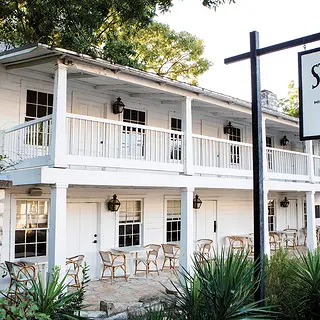
Why Austin, Texas, Developer Clark Lyda Likes Old Buildings
Austin, Texas–based investor and real estate developer Clark Lyda has been a history buff since childhood. Much of his development work focuses on finding new uses for old buildings, creating an economic impetus for their preservation. We spoke with him recently about some of his latest projects.
How did you become interested in historic places?
I grew up out in the country in Central Texas, around the late 1960s and early ’70s, when a lot of older places in Texas were still intact. My mother was very interested in history and collected antiques. It was just part of my life. So when things started disappearing in Central Texas around the early 1980s, during an economic growth spurt, it was disorienting and threatening to me. When I started investing in real estate, I gravitated toward odd properties people didn’t know what to do with, rather than conventional properties. Those tended to be properties with some history.

photo by: Drew Kelly
What appeals to you about adaptive reuse?
My theory is that historic buildings get torn down because they lose their purpose. You’ve got to preserve the essence of them but give them an economic purpose—a sustainable reason for being—so they can continue forward. Older buildings tell us a story about the people who built them and the time they were built. Most tend to have a higher level of craft than ours do now. And better materials, and more respect for resources. I’ve had varying degrees of success with them, but I find them to be more compelling.
What’s a project you’re particularly proud of?
The Stagecoach Inn in Salado, Texas. The original part dates from 1860-ish. It was in bad shape when we got it; it had been allowed to deteriorate substantially. But the essence is intact.
One of the latest ones is another hotel, the Commodore Perry Estate in Austin. It’s had a lot of different people working on it. It was a 1928 property I had known since I went to school there in the 1970s, and it was a residence before that. We’re working with Stefanos Polyzoides, an amazing urbanist architect. After 10 years of cost and effort, it’s now open, or at least part of it is. I think it’s really lovely.
I’ve done a lot of adaptive reuse work on buildings that aren’t particularly significant; they’re just old buildings. You have this character of material and craft. Why not preserve that instead of tearing it down? We’ve tried to do that.

photo by: Jessica Attie
The renovated Stagecoach Inn in Salado, Texas, a Historic Hotel of America also shown at top, opened in 2018. Clark Lyda used state historic tax credits to help finance the project.
How have your hotels been doing in the pandemic?
We’re fortunate in that they are on larger sites and have largely external circulation. They have lots of outdoor dining spaces and gardens, and the rooms have private outdoor spaces. Lots of people from within Texas and even within Austin have been coming to get away from home. In addition to the obvious protocols with cleaning, distancing, masking, and all the other stuff everybody tries to do, we have the advantage of space. We can create relative safety.
What is your own house like?
It’s in Travis Heights, one of the oldest subdivisions in Austin. It was built in 1934 by the Reuters, a family of grocers. It’s much more like a San Antonio house, with white stone and a Ludowici tile roof. It’s very Spanish Colonial. We’ve upgraded the electrical and plumbing, but the interior and exterior are largely original.
What are some of your favorite historic places?
I have a real weakness for small West Texas towns—not the touristy ones! Also, I like the Menger Hotel in San Antonio. And I used to be a big fan of houses from the Gilded Age era, so I am drawn to places like Newport, Rhode Island, or Long Island, New York.



